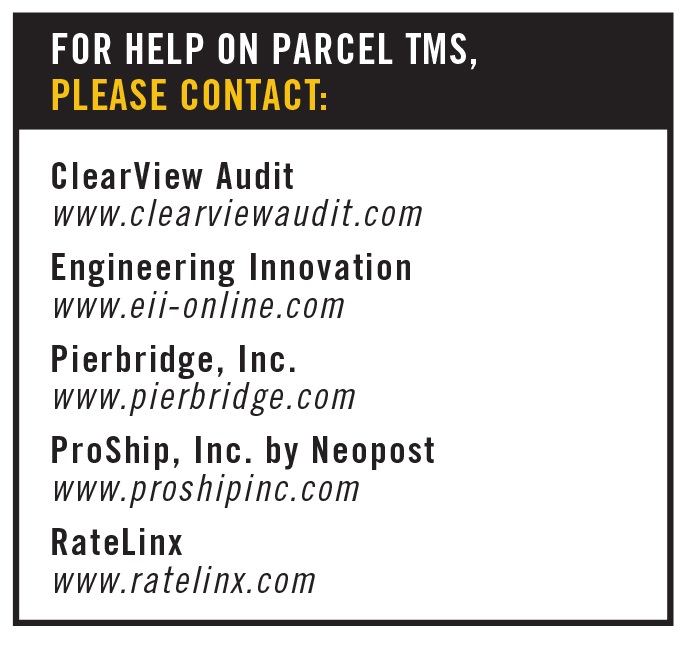This article originally appeared in the March/April issue of PARCEL.
Transportation management solutions (TMS) are getting a lot of attention these days as companies look for ways to optimize their delivery network and get control over rising freight costs. It’s a good time to be evaluating new solutions. New technologies and new vendors have given TMS systems a serious overhaul in terms of usability, configurability, deployment, and the total cost of ownership (TCO).
However, as many shippers have learned, identifying the best TMS solution for their specific industry and operations can be daunting. A quick search on the internet shows dozens of TMS systems offering a wide range of functionality from the planning of small parcel shipments to booking ocean freight and everything in between. Not surprisingly, honing in on the right solution takes time. Following are some thoughts to keep in mind:
Shipment Planning
Some TMS systems are built for multi-modal planning while others focus on one or two modes, so it’s important to “vet” each solution and the depth of functionality it truly delivers in the modes you use most. It should be built by logistics technology experts who have in-depth experience working with companies who match your shipping profile. For companies who primarily ship via LTL, truckload, rail and/or ocean freight, a multi-modal TMS planning system is often the best choice, deployed upstream of the WMS system.
However, for companies who predominantly ship small parcel freight, a better planning solution may be a robust shipping execution system that dynamically optimizes the shipments during execution after they’re received from the WMS system. The best systems include tools for shipment consolidation and the comparison of postal, small parcel, LTL, and regional carriers for lowest-cost delivery.
When executed well, you should expect your TMS to yield significant savings and a measurable ROI. Small parcel freight savings of up to 40% can be uncovered when shippers can compare small parcel carrier rates to the USPS and regional or local carriers.
Shipment Execution
Once the plan is set, what does the TMS solution offer to automate shipment execution and processing? This functionality crosses over from planning and into operations, but it should be a requirement because it can yield significant savings by eliminating manual shipping procedures. The system should offer a library of carrier-compliant shipping labels, carton contents labels, packing lists, advanced shipment notifications (ASNs), and other documents required by your trading partners. When automated label and document generation is well-integrated into the fulfillment workflow, the labor savings can be tremendous.
Carrier Integration
How are carrier rates and services managed by the TMS system? Has the vendor already onboarded the carriers you use into its system and, if so, how are rates, services, and updates handled? How are surcharges managed so that they can be included during planning and not show up as unexpected costs on the freight bill?
Which other carriers does the TMS vendor work with? If, for example, they’ve already integrated the USPS shipping rates and regional carriers into their platform, you may have the opportunity to reduce freight costs by leveraging these carriers.
Visibility
To control freight costs, it is vital to have comprehensive visibility into your carrier costs and delivery performance. A good TMS solution will provide reporting and analytical tools to support this process. It should also provide you with real-time visibility to track orders after they pass from planning to delivery, whether through EDI updates to partners and/or integration with your other host systems.
Deployment Costs
Years ago, a TMS was a high-priced solution purchased by large shippers. One reason for this was that implementations were complex, time-consuming, and required senior resources to deploy them. Today, customers can purchase cloud-based solutions, which are much easier and faster to deploy. A fair number of companies still prefer onsite installations, but fortunately, the deployment time for these configurations has also decreased as technology has evolved.
Related to this, user-configurability is another aspect to consider. The best solutions are moving toward user-configurable tools that enable the customer to change the software as their business changes, rather than relying on the vendor to make the modifications. As you are vetting solutions, come up with some scenarios that address this and compare how each system accommodates the changes.
Other Factors
As in any major purchasing decision, take the time to thoroughly review your vendor before signing a contract. How long have they been in business, and are they financially solid? How many companies use their solution? How large is their product development staff and support team? Also, ask for references that highlight success stories as well as challenging implementations that show how they resolved them. This is a partner you’re relying on to manage a core function of your operations, so you want to be sure that they have all the credentials to be a longstanding partner.
Plan for Change
Without a doubt, change is now a constant in supply chain management as the internet continues to revolutionize the way we source products for our businesses and homes. Companies who once seemed far removed from the e-commerce world now rely on it as their principal channel for revenue growth. Businesses that once sold products largely through distribution channels are now selling directly to end customers. Accommodating these new business practices takes nimble technology that facilitates effective planning and execution.

Bob Fischer, founder and CEO of ADSI, is a recognized logistics expert with 30 years of logistics technology experience. He can be reached at bfischer@adsionline.com. For more information on ADSI shipping software and dimensioning solutions, visit www.adsionline.com.
Click here to return to the Transportation Management topic page.













